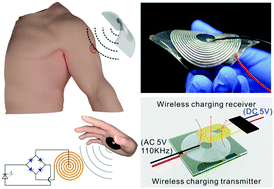Robust, multiscale liquid-metal patterning enabled by a sacrificial sealing layer for flexible and wearable wireless powering†
Abstract
Patterning of liquid metals (LMs) at different length scales remains one of the issues hindering their practical applications. Herein, we report a robust LM patterning method enabled by transiently sealing and subsequently dissolving a sacrificial layer (a polyvinyl alcohol (PVA) thin film or an adhesive tape). In this method, the LM was filled into the channels, which were temporarily formed by sealing with a sacrificial layer, by either negative or positive pressure. Afterward, LM patterns were obtained by the dissolution of the sacrificial layer in water. This method affords a robust generation of micro- and macro-patterns of LMs in a wide range from 30 μm to 1200 μm with high reliability. To demonstrate the potential application of this method, flexible and wearable LM-based wireless charging devices were fabricated, optimized and characterized. A power transfer efficiency (PTE) up to 60% was achieved while maintaining their function even at a bending radius of 12.5 mm. As a proof-of-concept, flexible LM-based wireless charging devices were employed to power passive, implantable and wearable devices.



 Please wait while we load your content...
Please wait while we load your content...